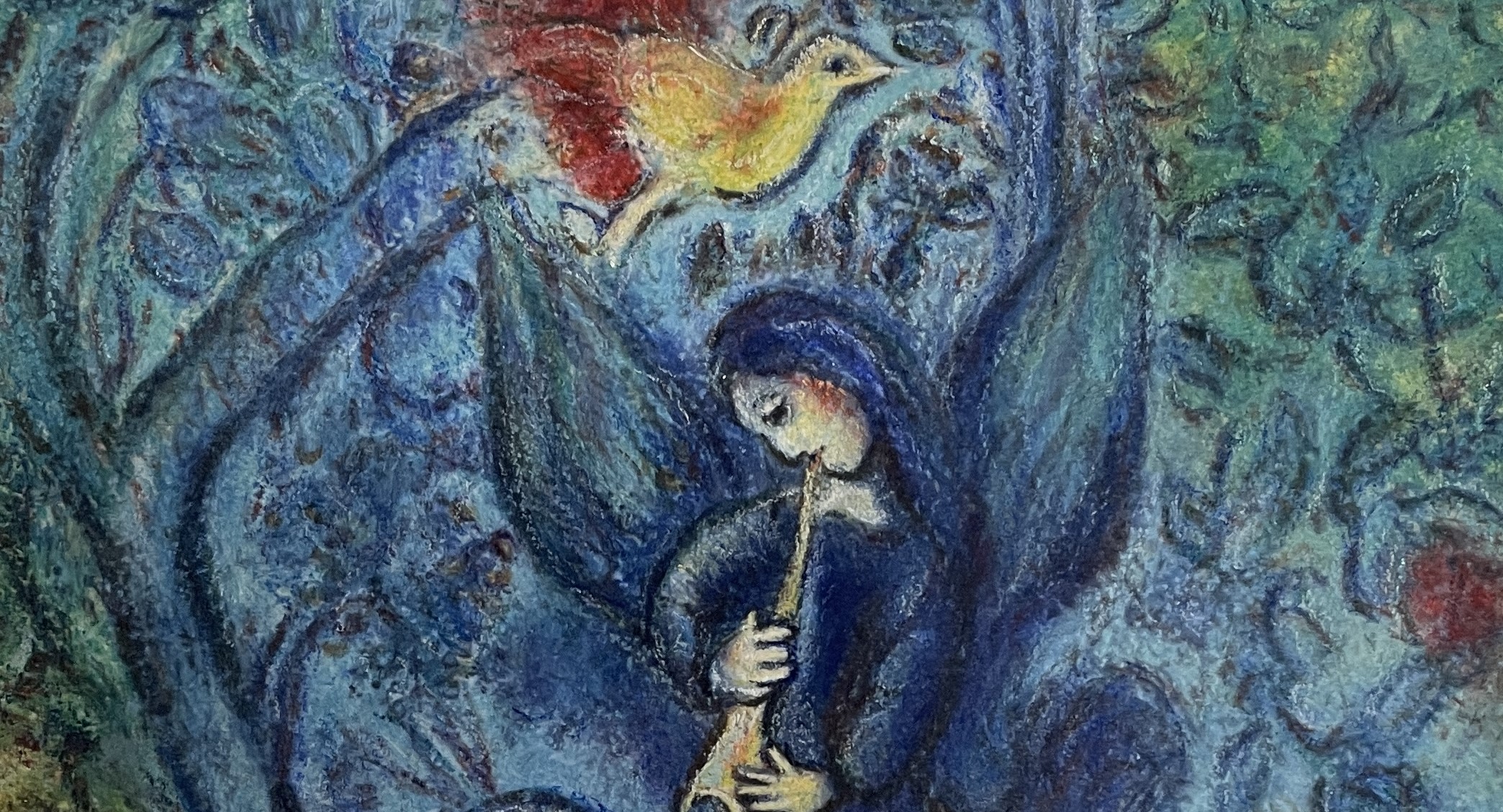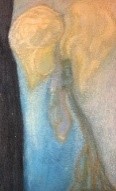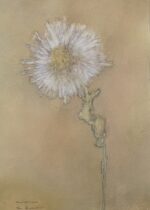日本語-Englishー台灣華語
ピート・モンドリアン「萎れゆく菊」
芸術家が未知のスタイルを見つけ出すために試行錯誤している時期の作品は、いつも刺激的だ。厳格なカルヴァン派の教育者の家庭に育ったモンドリアンは、若い頃、世紀末の画家ムンクの影響を受けた象徴的な絵を描いていた。対象に内包する霊性を表現しようとしていた。モンドリアンが初期に描いたこの菊の花は、色味が明るい割には暗い印象を与えるが、実物は味わい深い魅力がある。彼の絵画の中では最も感情的な作品である。今を盛りに咲き誇る花ではなく、瀕死の花である。まるで女性に打ち負かされて萎れている男のようだ。この絵を描いた時、モンドリアンは酷い失恋をしたのかもしれない。溶解して崩れ去りそうなこの絵には、儚くも移ろいやすい自然現象の奥にある不変の原理が描かれている。それは生と死を象徴している。モンドリアン絵画を規定する二元論的な発想の萌芽を見ることができる。
この絵は死を暗示する骸骨を表現したとも言われているが、私は描いていてむしろ脳の死を想起した。脊髄から連なる脳髄が次第に壊死して記憶がもうろうとなり、命の炎がまさに消えようとしているかのように思えてくるのだった。
モンドリアンはその後、神秘主義の画家ヤン・トーロップに影響を受けるが、次第に抽象に傾斜して行く。モンドリアンはキュビズムに出会い、そして一気にキュビズムを突き抜け、「色彩と形態のみの純粋な絵画」という未開の領域に突き進む。対象の描写から本質的でない部分を次々に省いて行く。モンドリアンは言っている。「私は色彩を放棄するのではなく、ただ可能な限り力強い色彩を望んでいるのだ。私は線を疎かにするのではなく、最も力強い線が欲しいのだ」と。そして遂に二つの造形要素に辿り着く。その一つの要素は水平と垂直の「線」の均衡である。眼前に広がる水平の大地と、天空に垂直にそびえる構築物こそが本質的要素だと確信する。もう一つの要素は、原色と無彩色の「色」の均衡である。原色はものが存在する状態を現わし、無彩色はものが存在しない空白を現わす。こうしてモンドリアンは、黒い直線でグリッド(格子)状に構成された白い平面の上に、「赤」「青」「黄」の三原色の色面が配置された、あの有名な絵画に到達するのである。実物の絵には、画集では観ることができない苦悩の痕跡が残されていて好感が持てる。モンドリアンは言っている。「今までのあらゆる芸術は自然に追随する造形だった。自然を手本とし、自然の色や形を構成することによって本質を現わすしかなかった。しかし私は自然に頼らない本質的要素だけで造形に至る」と。モンドリアンが言うところの、究極的に抽象化された絵画に到達したのである。それは写実ではない、秩序と比率と均衡からなる構成の美である。その境地は著しく厳しく宗教的でさえある。
オランダに実際に行って見ると、人工的で幾何学的な地形が、モンドリアンを写実から決別させ構成美を追求する土壌になったことは、十分にあり得ると感じてしまう。起伏のない大地はあくまでも水平で、そこに木や建物がすっくと立っている。人間が男女の均衡によって成り立っているように、それはまるで天に向かう男性が、たおやかな女性にしっかりと支えられているように感じてしまう。 晩年ニューヨークに移り住んだモンドリアンは、同じ完全抽象画でありながら、自由で軽快な「ブロード・ウェイ・ブギ・ウギ」のような楽しげな絵を描いている。「絵画の現代性とは何か」を問い続けたモンドリアンは、現代の美は大都市の抽象的な生活に具現化すると考え、建築における面や線の均衡とリズムこそが、気まぐれな自然よりも、芸術家に多くのことをもたらしてくれると語っている。確かに、「自然美は造形美に勝る」という西洋の古典的な観念に挑んだモンドリアンは、その呪縛に挑戦して一つの境地を開拓したが、私はそこに閉塞感を感じてしまう。モンドリアンは厳格な完全抽象に至ってからも、水彩で花を描き続けていたという。
Dying Chrysanthemum
The period when artists are experimenting to find an unknown style is always exciting. Raised in a strict Calvinist educator’s family, Mondrian, in his youth, was drawing symbolic paintings influenced by the fin-de-siècle painter Munch, attempting to express the spirituality inherent in subjects. This early painting of a chrysanthemum by Mondrian, while having bright colors, gives a dark impression, yet the actual piece has a profound charm. It is among the most emotional works in his paintings, not depicting flowers in their prime but those on the verge of death, reminiscent of a man wilted from being defeated by a woman. When he painted this, Mondrian might have been going through a terrible heartbreak. The painting, appearing as if it could dissolve and collapse, depicts the transient and fickle nature of natural phenomena, symbolizing life and death, hinting at the genesis of the dualistic ideas that would define Mondrian’s paintings. It is said to represent a skeleton implying death, but while painting it, I rather recalled the death of the brain. The brainstem leading to the brain gradually necroses, blurring memories, as if the flame of life is about to extinguish.
Mondrian was later influenced by the mystic painter Jan Toorop, but gradually leaned towards abstraction. He encountered Cubism and quickly broke through it, venturing into the unexplored territory of “pure painting of color and form alone,” eliminating non-essential parts from the depiction of objects. Mondrian said, “I am not abandoning color, but I desire the most powerful color possible. I do not neglect lines, but I want the most powerful lines.” He finally arrived at two elements of form: the balance of “lines” horizontal and vertical, convinced that the essential elements are the horizontally spread earth and the vertically soaring constructions. The other element is the balance of “colors” primary and achromatic, with primary colors representing the state of existence and achromatic colors representing the void of non-existence. Thus, Mondrian reached his famous paintings with red, blue, and yellow primary color planes placed on a white surface composed of black linear grids. The actual paintings bear traces of anguish not visible in reproductions, which is appealing. Mondrian stated, “All art until now has been mimetic, taking nature as a model, revealing essence through the composition of natural colors and shapes. However, I aim to achieve form through essential elements independent of nature.” He reached the ultimate abstraction, a composition of beauty derived not from realism but from order, proportion, and balance, a realm significantly stern and even religious.
Visiting the Netherlands, one can feel that the artificial, geometric landscape could have indeed been the basis for Mondrian to break away from realism and pursue compositional beauty. The unendingly horizontal land with trees and buildings standing straight up, as if a man reaching towards heaven is firmly supported by a gentle woman, mirroring the balance of genders in humanity.
In his later years, moving to New York, Mondrian painted joyful works like “Broadway Boogie Woogie,” maintaining complete abstraction but with a freer, more spirited touch. Continuously questioning “what is the modernity of painting,” Mondrian believed that modern beauty materializes in the abstract life of large cities, arguing that the balance and rhythm of lines and planes in architecture offer more to artists than capricious nature. Indeed, challenging the classical Western notion that “natural beauty surpasses formal beauty,” Mondrian broke free from its spell, although I feel a sense of closure in that achievement. Even after reaching strict complete abstraction, Mondrian continued to paint flowers in watercolor.
彼得·蒙德里安「凋零的菊花」
對於藝術家來說,在尋找未知風格的過程中進行試錯,總是令人振奮的。在嚴格的加爾文主義教育家庭長大的蒙德里安,年輕時受到世紀末畫家蒙克影響,畫過象徵主義畫作,試圖表達物體內在的靈性。他早期畫的這朵菊花,雖然色調明亮,卻給人一種陰沉的感覺,但實物卻有著深邃的魅力。這是他畫作中最具情感表達的一件。不是盛開的花,而是垂死的花,彷彿被女性打敗般凋零。畫這幅畫時,蒙德里安可能經歷了一次嚴重的失戀。畫中似乎要溶解般崩壞的形象,描繪了自然界易逝且變幻的現象背後恆定的原則,象徵生與死。可以看到蒙德里安畫作中二元對立思想的萌芽。這幅畫也被認為表現了死亡的骷髏,但我反而想到了大腦的死亡。脊髓連接的腦髓逐漸壞死,記憶變得模糊,彷彿生命之火即將熄滅。
蒙德里安後來受到神秘主義畫家揚·托洛普的影響,但逐漸傾向於抽象。他遇到了立體主義,然後一躍超越,進入了僅以「色彩和形態」構成的純粹畫作的未開墾領域。他去除了畫作中非本質的部分。蒙德里安表示:「我不是放棄色彩,而是尋求盡可能有力的色彩。我不忽視線條,而是想要最有力的線條。」最終他達到了兩個造型要素:一是水平與垂直線條的平衡;二是原色與無彩色的平衡。原色表現物體存在的狀態,無彩色表現不存在的空白。因此,蒙德里安達到了那些以黑色直線在白色平面上構成格狀,並配置「紅」「藍」「黃」三原色的著名畫作。
實際的畫作留有苦悶的痕跡,令人感到親切。蒙德里安說:「所有以往的藝術都是追隨自然的造型。只能通過模仿自然,用自然的色彩和形態來表現本質。但我追求的是不依賴自然,只用本質元素來進行造型。」蒙德里安的畫達到了極端抽象化,不是寫實,而是秩序、比例和平衡構成的美。這種境界是極其嚴格且幾乎具有宗教性的。
實際去荷蘭看看,會感受到人工幾何學地形可能成為蒙德里安從寫實轉向構成美追求的土壤。平坦的大地上,樹木和建築筆直地矗立。就像男女平衡構成人類一樣,彷彿直指天際的男性被溫柔的女性穩固支持。
晚年移居紐約的蒙德里安,雖然依然是完全抽象畫,卻畫出了自由而輕快的「百老匯布吉舞曲」等歡樂畫作。蒙德里安持續探問「畫作的現代性是什麼」,認為現代之美體現在大都市的抽象生活中,建築中面和線的平衡與節奏,比變幻莫測的自然給藝術家帶來更多。蒙德里安挑戰西方「自然美勝過造形美」的傳統觀念,開拓了新境界,但我卻感到了某種閉塞感。即使達到嚴格的完全抽象,蒙德里安仍然持續用水彩畫花。




